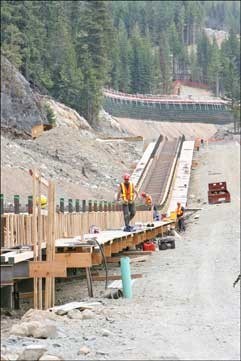Curve 16, the final turn before the finish line, is covered in dust and dirt.
Up above a skeletal outline of a massive track etches its way down Blackcomb Mountain.
If you close your eyes to the blistering sun you can almost hear the scraping slide of a bobsled plunging down the ice and see the chilly fog of spectators’ breaths cheering on the athletes from around the world. It just takes a little imagination.
For an athlete who is willing to tackle what will become one of the fastest bobsled/luge/skeleton tracks in the world, this visualization process is critical to success.
"When we were here last summer there was a lot of earth movers and a lot of activity but nothing that really resembled a track, and now it’s starting to take shape," said Olympian Duff Gibson, who took home the gold for Canada in the skeleton event at the 2006 Torino Olympics. "So athletes who visit here from this point forward will be able to begin to start that visualizing, imagining what kind of steering will be required for the different corners, what that atmosphere will be like at the Games a little under four years from now."
Today, however, on what will be curve 16 of the Whistler Sliding Centre it’s hot and dusty.
Work is well underway and the track should be ready for athletes by the end of 2007, giving Canadian sliders an edge over the competition.
"It takes hundreds of runs before you really know a track to the best of your ability," said Gibson.
"If our Canadian athletes can have potentially 200 or 300 runs before the Games, that’s a huge advantage here."
But before the concrete can be poured it will meticulously tested in a nearby mockup area. It will be tested again after it is smoothed onto the track. There is no room for error, not even a discrepancy of two millimetres difference from the track design.
That’s because athletes will be hugging the icy surface at speeds of 140 kilometers per hour in their quest for Olympic gold.
"To see them test (the concrete), to perfect what they’re doing so that they get it right the first time, it feels great," said John Furlong, CEO of the Vancouver Organizing Committee for the 2010 Games.
"We’re about to have one of only 15 or so of these tracks in the world right here in Whistler – it’s just a tremendous asset for us."
At Tuesday’s Whistler Olympic venue tour, Furlong was upbeat and positive about progress in Whistler on the four main Olympic sites – the Nordic Centre in the Callaghan Valley, the athletes’ village in the Lower Cheakamus, the alpine venue in Creekside and the sliding centre on Blackcomb,
"We’re in the happy position of having a schedule that’s in great shape," said Furlong.
The goal, he said, is to deliver "absolutely spectacular venues" on time and on budget.
And get Canadian athletes training on them before the 2010 Games.
When asked if it was hard to believe these venues would be hosting the 2010 Games three and half years from now Furlong said: "It’s beginning to feel more like it’s not hard to believe anymore because you can now see the shape of these venues…"
The Whistler Nordic Centre
The finish line of the 2010 biathlon events is just as dirty and dusty as the finish area of the sliding track. But progress is evident too on the $115.7 million development.
A 90-metre long concrete wall abuts a tall forest; this is where biathlon athletes will aim their rifles at a six-inch target.
The ski jumping venue is also starting to take shape, its steep descent carved out of 80,000 cubic metres of blasted rock. That’s a soccer field piled 25 metres high with rock.
The Nordic Centre, tucked up in the Callaghan Valley, will be Whistler’s busiest Olympic venue – 30 Olympic gold medals will be fought for here, as well as 32 Paralympic gold medals. More than 12,000 spectators will journey up the road beneath snow-capped mountains to watch cross-country skiing, ski jumping and Nordic combined events from three separate stadiums.
Alpine Skiing
In comparison to the huge $100 million-plus developments elsewhere in the valley, work at the alpine skiing site is fairly minimal.
Crews began the work this summer on the $26 million improvements for the alpine skiing events in Creekside. It is set to wrap up by summer 2008.
Former Olympian and hometown athlete and women’s national team coach Rob Boyd has surveyed the work and he likes what he sees so far.
"It’s going to be probably one of the toughest courses out there of all the World Cup courses and Olympic courses I’ve seen for the women," he said, standing at the Timing Flats below the downhill runs.
Whistler’s Athletes’ Village
The future site of the village still looks very much like the current site of the town dump, complete with hungry black bears. That’s because all the environmental approvals were just recently given, finally allowing crews to get on site.
The $130 million development will house Whistler’s athletes and coaches during the Games and be tranformed into employee housing post-Games.




